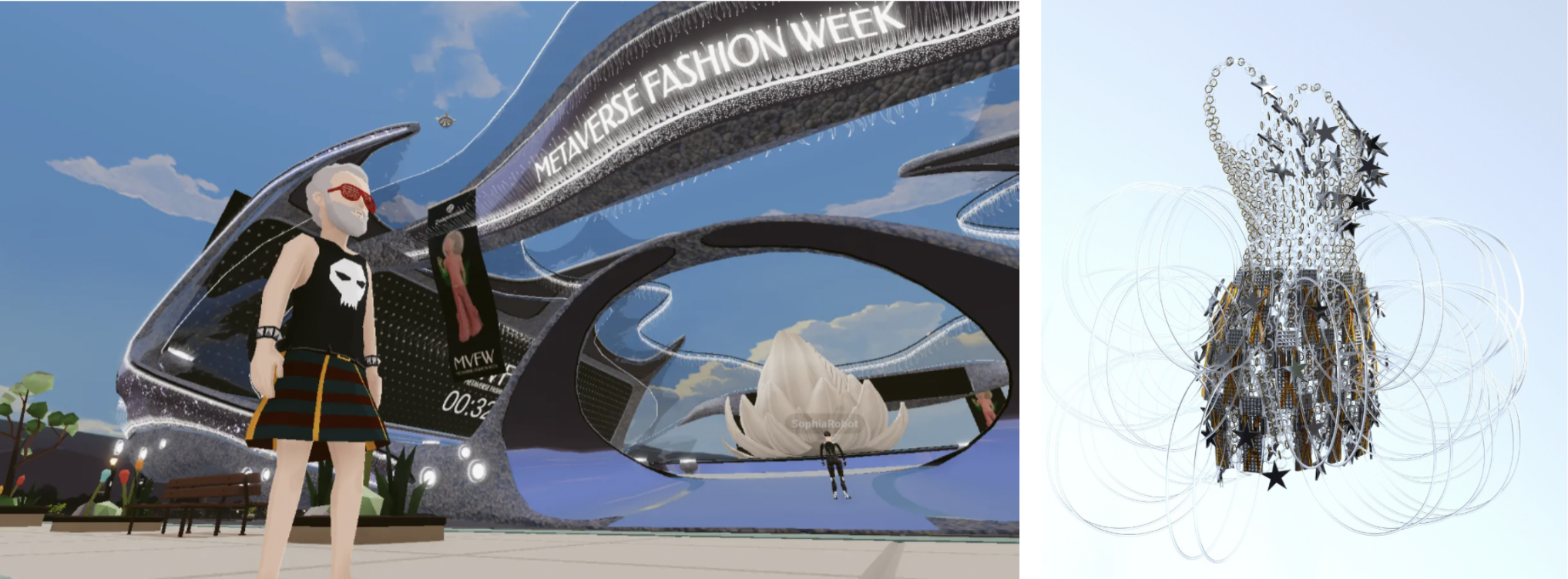Designs Gone Digital: A Look Inside Metaverse Fashion Week
Graphic by Quynh-Nhi Tran.
Every September, four weeks of elaborate runway shows draw industry professionals and consumers alike to see what the biggest month in fashion will reveal about upcoming trends. Paris, Milan, London, New York — Fashion Week gives these already-famed cities another claim to their image of cosmopolitan glamor. Now swap the Carrousel du Louvre for the metaverse, flesh-and-blood models for avatars and designer pieces for NFTs. Behold: the first event of its kind to take Fashion Week digital.
Metaverse Fashion Week (MVFW) launched in 2022 and is set to return in March of this year. The event is hosted by Decentraland, a 3D virtual world platform on the Ethereum blockchain. Last year it featured over 60 designers, including luxury labels like Paco Rabbane, Dolce & Gabbana, Etro and Tommy Hilffiger.
The event is designed to be a digital space that celebrates fashion. In it, you can attend runway shows featuring digital designs, buy pieces being sold as NFTs, attend after parties, “meet” designers and shop in stores. It even allows visitors to try on “wearables” for themselves.
Left image courtesy of Vogue. Right: Paco Rabanne NFT dress, image courtesy of Show Studio.
Last year, high fashion shows were hosted in the Luxury District, one of the digital venues visitors could move between. Here, Dolce & Gabbana featured 20 looks on anthropomorphic, cat-headed models, sporting suits with dramatic shoulder pads and spray-painted logomania. Their website boasts the Metaverse collection as an expansion of their artistry to “new horizons.”
Image courtesy of Dolce and Gabbana.
They are not the only ones painting the event as a step into fashion’s future. Emperia, a virtual reality retail space, says that Metaverse Fashion Week emphasizes the experience of the consumer, offering new avenues to engage with fashion and to express themselves. Their rhetoric evokes idealistic images of a more inclusive world of fashion that brings people together — more so than the industry does in the “real world.”
It’s true that the high fashion industry leaves out the vast majority of people. Seats at fashion shows are reserved for moguls of the arts, A-listers and the well-connected. Meeting a designer only happens at after parties thrown for that same exclusive crowd. Most spaces in fashion are reserved for those who are privy to that world, the entrance to which is well guarded and comes with a password. So it cannot be discounted that digital spaces like Metaverse Fashion Week offer the accessibility that is so limited in “real world” fashion. But recontextualizing fashion into a digital sphere might not necessarily preserve many of the elements that are fundamental to fashion.
Fashion has always existed as a physical form of self-expression. What we choose to put on our bodies, how it's made, who conceptualized it —it all comes down to labor, craftsmanship, design, creativity and fundamentally, people. Technology becoming a part of this process is nothing new. But there is a critical caveat that comes with the promises of more than what the “real world” can offer. Can a designer’s ethos and craft be represented by pixels, ones and zeroes? Are people really expressing themselves when their avatar buys a piece their biological host can’t wear? Is fashion really made more accessible when the world disappears the moment you turn away from the screen?
The metaverse and events like Metaverse Fashion Week provide access to stylish spaces many people can’t otherwise experience. It does not mean, however, that the labels assigned to these spaces aren’t misleading, promising fashion and all it has the power to do in a way that fundamentally contradicts itself. Eventually, the real world is what we return to, and all those tools for creativity and self-expression that were promised may or may not follow us into it.



